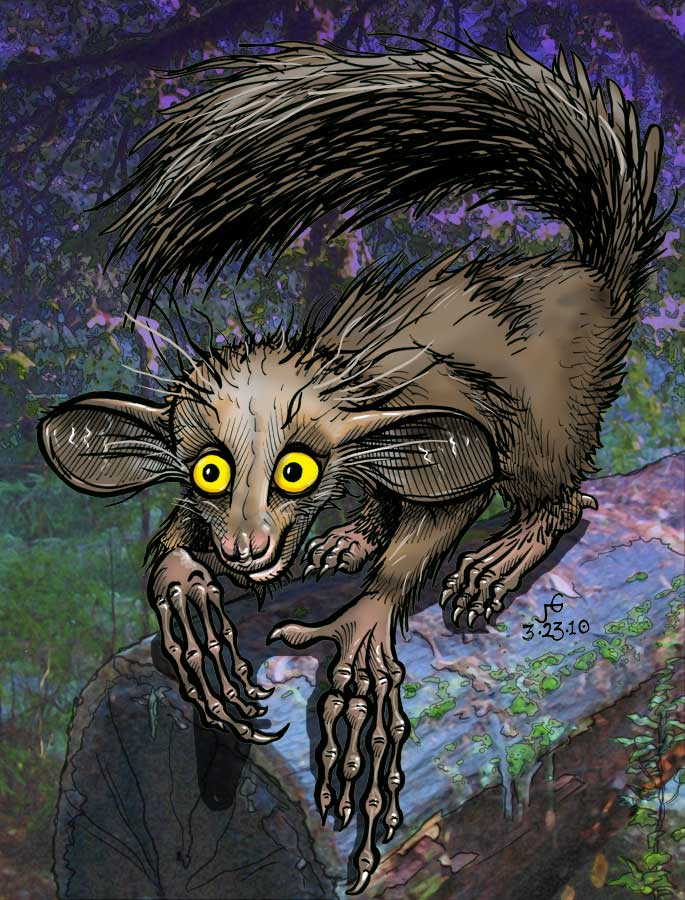
These obscure Madagascan lemurs are one of the many highly endangered species on this planet. Most endangered species (I'm looking at you snow leopards!) manage to cut a fierce visage which strikes fear into the hearts of men. The aye-aye, however, is a hopelessly timid looking critter which hides in jungle canopies under cover of night. It is all the more odd then that indigenous people have long lived in fear of these small squirrel-like animals.
In earlier times aye-ayes were 'fady'. The appearance of an aye-aye among people was an omen of death and bad luck, and they were not to be eaten or killed. Luckily for the Malagasy people aye-ayes are usually very timid, and hid in the deepest parts of the jungle.
Sadly these jungles are quickly disappearing, and Aye-ayes have been forced to come out of the forests and compete with farmers for food by stealing coconuts and cane sugar. Natives have responded by killing aye-ayes whenever they see them. Such killing is still sometimes believed to bring bad luck, so the corpses of slain aye-ayes are moved about like hot potatoes. Nobody wants to be the one to dispose of the magical beast's remains.
Aye-ayes, (Prosimians Dubodentae madagascariensis) are now a highly endangered species. These nocturnal omnivores are possibly one of the most endangered species on the planet. They are certainly the rarest of the lemurs. Lemurs are sort of hold-over from the days of tree-dwelling mammals, just before monkeys and other apes came around. Lemurs existed across Africa in prehistoric times. Now lemurs only live on a comparatively small landmass off of the coast of Africa known as Madagascar. And while there were once more than 40 species of lemur on Madagascar, there are now only 21 types of lemur. There are perhaps as few as 100 individual aye-ayes in the wild at this time, and they are still losing their forest habitat at an alarming rate.
 So why all the fuss about aye-ayes? Well, they just look weird. Wide orange eyes on a catlike face, giant grasping hands with an eerily elongated middle finger, and a long bushy tail make them unique in the animal world. First described in 1782, this unusual animal has confused scientists with regard to classification for some time. It has been taken for some sort of rodent, a squirrel, and has even had its own separate primate order. Although aye-ayes share some traits with other Madagascan lemurs, they are now given their own family in the lemur group.
So why all the fuss about aye-ayes? Well, they just look weird. Wide orange eyes on a catlike face, giant grasping hands with an eerily elongated middle finger, and a long bushy tail make them unique in the animal world. First described in 1782, this unusual animal has confused scientists with regard to classification for some time. It has been taken for some sort of rodent, a squirrel, and has even had its own separate primate order. Although aye-ayes share some traits with other Madagascan lemurs, they are now given their own family in the lemur group.
Aye-ayes are highly specialized animals, well adapted to their unique environment, and have a very unusual mode of feeding. They usually feed on beetle larvae from tree bark and bamboo pith, they will also eat sugar cane, coconut, mangoes, bananas, dates, eggs, and cooked rice when offered.
Ayes-ayes use their elongated middle finger for feeding by burrowing into the bark of trees to fetch out the tasty insects within. Their finger is also used in drinking, lapping up liquid much like a dog's tongue. This long thin finger is a sort of all purpose tool.
The call of the aye-aye is thought to be source of its name, but Aye-ayes are now known to make a call which sounds like metal scraping on metal. The sound is thus not an aye-aye, but rather more of a rron-tsit. This sound is made when aye-ayes are startled, like when someone shines a light into their large, round sensitive eyes.
In Madagascan folklore this nocturne plays an important role as the magical keeper of the forest. If you sleep out in the forests an aye-aye will prepare you a cushion of grass. If you find that the aye-aye has placed the cushion under your head as you slept you can be sure of good luck and great riches. If the aye-aye places the cushion under your feet you will become ill and fall pray to the magic of sorcerers and bad luck. Anyone who kills an aye-aye will die within the year. Sadly these beliefs are quickly giving way to the grim battle between aye-ayes and locals for the diminishing natural resources of the island nation of Madagascar.
When I was a child I saw a picture of these strange animals on a poster and became fascinated. Over the years I have looked for information wherever I could about these rare beings. Sadly there is little printed material about Aye-ayes, although that is changing slowly. Recently zoos and universities have made great strides in the area of captive breeding of these extremely rare animals.
Books about aye-ayes (and other things too!):
Adams, Douglas; Last Chance to See; Ballantine Books, 1990; ISBN 0-345-37198-4
Durrell, Gerald; The Aye-Aye and I; Simon & Schuster, 1992; ISBN 0-671-88439-5
Here are some good sources for more information about aye-ayes; straight from the experts:
Duke University's Aye-aye Page (Photographs appear courtesy of Duke University Primate Research Center)
The Wild Ones Aye-aye Page
Aye-ayes: Species Under Threat
6000 Tigers Aye-aye Page
NOVA Online Interview w/ Eleanor Sterling
Toy aye-aye, and other toy lemurs

 Click on one of the navigation slices to view other sections.
Click on one of the navigation slices to view other sections.